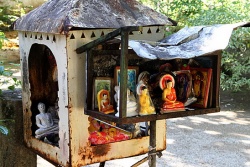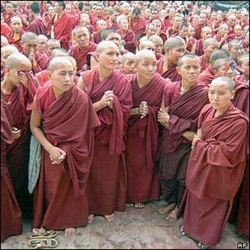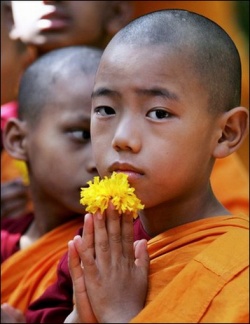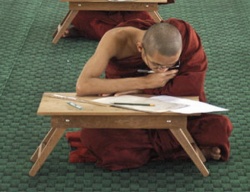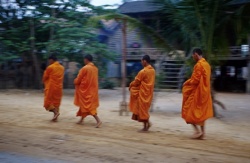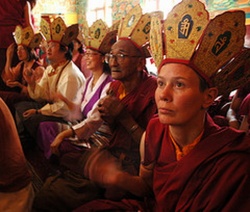Je Khenpo
- See also Buddhism in Bhutan
[[File:65622_12th_Je_Khenpo.jpg|thumb|250px|The Twelfth Je Khenpo, Kunga Gyatso)]
The Je Khenpo (Tibetan: རྗེ་མཁན་པོ་, Wylie: Rje Mkhan-po; "The Chief Abbot of the Central Monastic Body of Bhutan"), formerly called the Dharma Raj by orientalists, is the title given to the senior religious hierarch of Bhutan.
His primary duty is to lead the Dratshang Lhentshog (Commission for the Monastic Affairs) of Bhutan, which oversees the Central Monastic Body, and to arbitrate on matters of doctrine, assisted by lopons (learned masters).
The Je Khenpo is also responsible for many important liturgical and religious duties across the country. The sitting Je Khenpo is also formally the leader of the southern branch of the Drukpa Kagyu sect, which is part of the Kagyu tradition of Himalayan Buddhism. Aside from the King of Bhutan, only the Je Khenpo may don a saffron kabney.
History
According to the dual system of government established by the Shabdrung Ngawang Namgyal in the 17th century, the powers of the government of Bhutan are ideally split between the religious branch, headed by the Je Khenpo, and the administrative branch, headed by the Druk Desi. The position of Je Khenpo is granted on merit by election, and typically is given to the most respected monk in the Dratshang Lhentshog (Commission for the Monastic Affairs).
Thus, unlike reincarnation lineages such as the Dalai Lama, Shabdrung, or Panchen Lama, the position of Je Khenpo is never held by a child but always by a seasoned monk.
Historically, the role of the Je Khenpo was quite powerful. The Je Khenpo and Druk Desi collaborated to disempower the office of the Shabdrung through finding multiple incarnations of various aspects of the Shabdrung; both the Je Khenpo and the Druk Desi wanted to retain the power they had accrued through the dual system of government. However, since the establishment of the monarchy in 1907, the relative influence of the Je Khenpo has diminished. Nonetheless, the position remains a powerful one and the Je Khenpo is typically viewed as the closest and most powerful advisor to the King of Bhutan.
The 67th Je Khenpo, Ngawang Thinley Lhundup, died at the age of 84 on June 10, 2005. He was noted as a strict disciplinarian who would not compromise any rules in managing the Central Monastic Body. In addition to his position as Je Khenpo, he was recognized as the tulku of Nyizergang, the seat of the terton Woogpa Lingpa, in Wangdue Phodrang province.
The 70th and present Je Khenpo is Tulku Jigme Chhoeda. He is believed to be the reincarnation of Maitreya, as well as the mahasiddha Saraha, Hungchen Kara, Kheuchung Lotsawa, and Pema Tsering.
In 2008, the office of the Je Khenpo was codified as part of Bhutan's Constitution. Under Article 3 Section 4, the King appoints the Je Khenpo as the spiritual leader of Bhutan on the recommendation of the Five Lopons. In turn, the Je Khenpo appoints, on the recommendation of the Dratshang Lhentshog (Commission for the Monastic Affairs), monks with the nine qualities of a spiritual master and accomplished in ked-dzog (stages of development and completion in Vajrayana practice) as the Five Lopons.
List of Je Khenpos
17th century
| Number | Name | Tenure |
|---|---|---|
| 1 | Pekar Jungney | ? – 1672 |
| 2 | Sonam Ozer | 1672 – 1689 |
| 3 | Pekar Lhündrup | 1689 – 1697 |
| 4 | Damchö Pekar | 1697 – 1707 |
18th century
| Number | Name | Tenure |
|---|---|---|
| 5 | Zödpa Thinley | 1707 – 1724 |
| 6 | Ngawang Lhündrup | 1724 – 1730 |
| 7 | Ngawang Thinley | 1730 – 1738 |
| 8 | Tenzin Norbu | 1738 – 1744 |
| 9 | Shakya Rinchen | 1744 – 1755 |
| 10 | Tenzin Chögyal | 1755 – 1762 |
| 11 | Ngawang Thinley | 1762 – 1769 |
| 12 | Kunga Jamtsho | 1769 – 1771 |
| 13 | Yönten Thaye | 1771 – 1775 |
| 14 | Tenzin Namgyal | 1775 – 1781 |
| 15 | Kunzang Gyaltsen | 1781 – 1784 |
| 16 | Sherab Singye | 1784 – 1791 |
| 17 | Jamgön Yeshi Dorji | 1791 – 1797 |
| 18 | Jamyang Gyaltshen | 1797 – 1803 |
19th century
| Number | Name | Tenure |
|---|---|---|
| 19 | Ngawang Chögyal | 1803 – 1807 |
| 20 | Yeshey Gyaltshen | 1807 – 1811 |
| 21 | Jampyel Drakpa | 1811 – 1816 |
| 22 | Jigme Gyaltsen | 1816 – 1826 |
| 23 | Jampyel Drakpa | 1826 – 1831 |
| 24 | Shakya Gyaltsen | 1831 – 1836 |
| 25 | Sherab Gyaltsen | 1836 – 1839 |
| 26 | Yönten Jamtsho | 1839 – 1840 |
| 27 | Pema Zangpo | 1840 – 1847 |
| 28 | Rinchen Zangpo | 1847 – 1848 |
| 29 | Pema Zangpo | 1848 – 1850 |
| 30 | Jampyel Jamtsho | 1850 – 1851 |
| 31 | Yönten Gyaltsen | 1851 – 1858 |
| 32 | Tshultrim Gyaltsen | 1858 – 1860 |
| 33 | Künga Peljor | 1860 – 1861 |
| 34 | Shedrup Ozer | 1861 – 1865 |
| 35 | Shakya Gyaltsen | 1865 – 1869 |
| 36 | Yönten Pelzang | 1869 – 1873 |
| 37 | Künga Singye | 1873 – 1875 |
| 38 | Shakya Gyaltsen | 1875 – 1875 |
| 39 | Lodrö Gyaltsen | 1875 – 1878 |
| 40 | Pekar Ozer | 1878 – 1881 |
| 41 | Ngawang Dönden | 1881 – 1886 |
| 42 | Thinley Gyaltsen | 1886 – 1888 |
| 43 | Tenzin Lhündrup | 1888 – 1889 |
| 44 | Thinley Gyaltsen | 1889 – 1891 |
| 45 | Thinley Jamtsho | 1891 – 1894 |
| 46 | Damchö Gyaltsen | 1894 – 1899 |
| 47 | Sherab Lhündrup | 1899 – 1901 |
20th century
| Number | Name | Tenure |
|---|---|---|
| 48 | Jamyang Rinchhen | 1901 – 1903 |
| 49 | Rigzin Nyingpo | 1903 – 1907 |
| 50 | Jampyel Shenyen | 1907 – 1909 |
| 51 | Jampai Tobzang | 1909 – 1912 |
| 52 | Pelden Singye | 1912 – 1915 |
| 53 | Yeshey Ngödrup) | 1915 – 1917 |
| 54 | Yeshey Dawa | 1917 – 1918 |
| 55 | Pelden Singye | 1918 – 1918 |
| 56 | Mipham Wangpo | 1919 – 1922 |
| 57 | Ngawang Gyaltsen | 1922 – 1927 |
| 58 | Sidzhe Namgyal | 1927 – 1931 |
| 59 | Chökyi Wangchuk | 1931 – 1940 |
| 60 | Ngawang Thinley | 1940 – 1946 |
| 61 | Samten Jamtsho | 1946 – 1955 |
| 62 | Yönten Tsündu | 1955 – 1956 |
| 63 | Thinley Lhündrup | 1956 – 1961 |
| 64 | Samten Pelzang | 1961 – 1965 |
| 65 | Yeshey Singye | 1965 – 1968 |
| 66 | Yönten Tarchen | 1968 – 1971 |
| 67 | Nyizer Thinley Lhendrup | 1971 – ? |
| 68 | Tenzin Dundrup | ? – 1990 |
| 69 | Gendün Rinchen | 1990 – 1996 |
| 70 | Trulku Jigme Chhoedra | 1996 – present |
21st century
| Number | Name | Tenure |
|---|---|---|
| 70 | Trulku Jigme Chhoedra | 1996 – present |
